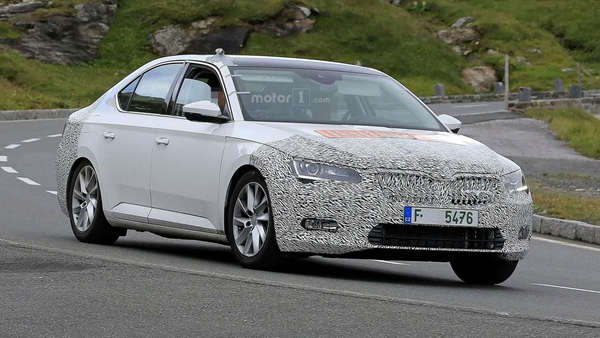
第三代速派快背车和旅行车去年刚刚发布,谍照记者就在最近拍到了疑是其改款车的照片。这辆白色原型车当时正在进行测试,但没有看到任何外观变化,除非在车身伪装下隐藏着更大变化。这辆原型车在车顶配备了传感器或摄像头,这表明斯柯达正在对安全或辅助驾驶系统进行测试。由于该车采用大众的MQB平台,因此很多配置将与帕萨特共享。速派还将提供取自大众的一系列安全设备,只不过某些设备还在开发之中。另一个值得注意的是,该车的行驶高度很低,这表明新车悬挂进行了重新调校。虽然这次没有拍到内装照片,但该车将提供取自Kodiaq的信息娱乐系统。该车很可能搭载一台280马力2.0升四缸涡轮引擎和全轮驱动系统。顶级款vRS功率将超过300马力,另外,新车还将配备更硬悬挂。这辆原型车究竟是改款车还是斯柯达只是利用其进行新设备的测试目前还有待观察。明锐改款车预计将于2018年底或2019年初发布,距离现行版上市四年。
Skoda already cooking up Superb facelift?
The third-generation Superb liftback and wagon came out just last year, so it’s a bit surprising to see Skoda’s range-topping model already preparing for a revision. That being said, the white prototype caught on camera earlier this week undergoing testing did not seem to carry any visual tweaks, unless there was something going on underneath the swirly camouflage.
The prototype was carrying some sort of a sensor or camera on its roof which might indicate Skoda was testing new safety and/or assistance systems. Being a member of the MQB family and sharing most of the bits and pieces with the plushier Volkswagen Passat, the Superb already has access to the group’s array of safety kit, but something new could be in the works. Also noticeable is the considerably lowered ride height compared to the regular model, and it could be a sign of some suspension tweaks inbound for the revised Superb.
While the interior cabin did not seem to be camouflaged at all, chances are Skoda will implement the new infotainment system set to debut on the Kodiaq seven-seat SUV which will have its world premiere tomorrow.
The most powerful model on sale today is the 280-hp version featuring a turbocharged 2.0-liter, four-cylinder engine linked to an all-wheel-drive system. A potential range-topping vRS would obviously have well over 300 hp and other mechanical tweaks, including a stiffer suspension setup.
It remains to be seen whether the prototype photographed is a sign of a facelift or Skoda was testing some new kit that will be added in the next model years. Chances are the mid-cycle update will be introduced at the end of 2018 or early 2019, almost four years after the current-gen’s introduction.